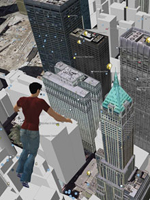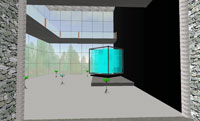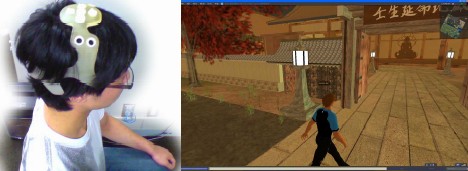Jun 05, 2009
Web VR: Now possible with O3D
This is a demo that demonstrates the potential of rendering 3D graphics in the browser, using O3D, an open-source web API for creating rich, interactive 3D applications in the browser. The app shown in the video is coded in javascript and html and runs in a web browser.
13:11 Posted in Virtual worlds | Permalink | Comments (0) | Tags: virtual reality, virtual worlds, open source
Nov 05, 2008
Exit reality
ExitReality’s is a new 3D web service that will create virtual versions of every social network site profile.
The London startup has now officially launched its beta. The free Internet plug-in allowing the 3d experience can be downloaded here.
23:38 Posted in Virtual worlds | Permalink | Comments (0) | Tags: virtual worlds
Oct 12, 2007
Brain-computer interface for Second Life
18:04 Posted in Brain-computer interface, Virtual worlds | Permalink | Comments (0) | Tags: brain-computer interface, virtual worlds
Sep 16, 2007
Phone calling from Second Life
Via Textually.org
C/net reports that BT is developing services that will enable users of virtual worlds to call or text out to their colleagues and friends in the real world. "To test the technology it has built a private island in Second Life, which it has dubbed Area 21 - a play on the ultra-secret Area 51 and BT's 21CN network technology, which is being used in the service"
22:21 Posted in Telepresence & virtual presence | Permalink | Comments (0) | Tags: virtual worlds
Jul 24, 2007
Second Life Running on Nokia n800

Second Life resident Wrestling Hulka has a limited version of the virtual world running on the Nokia n800.
another mobile client for Second Life was developed by Comverse earlier in the year
21:25 Posted in Virtual worlds, Wearable & mobile | Permalink | Comments (0) | Tags: virtual worlds
Jun 24, 2007
Toward a Metaverse

In this interesting article recently published in Technology Review, Wade Roush predicts that the line between the real world and its virtual representations will soon start blurring. Here is an excerpt from the article:
[...] The first, relatively simple step toward a Second Earth, many observers predict, will be integrating Second Life's avatars, controls, and modeling tools into the Google Earth environment. Groups of users would then be able to walk, fly, or swim across Google's simulated landscapes and explore intricate 3-D representations of the world's most famous buildings ... A second alternative would be to expand the surface area of Second Life by millions of square kilometers and model the new territory on the real earth, using the same topographical data and surface imagery contained in Google Earth ... That's a much more difficult proposition ...
[W]ithin 10 to 20 years--roughly the same time it took for the Web to become what it is now--something much bigger than either of these alternatives may emerge: a true Metaverse ... It will look like the real earth, and it will support even more users than the Snow Crash cyberworld, functioning as the agora, laboratory, and gateway for almost every type of information-based pursuit. It will be accessible both in its immersive, virtual-reality form and through peepholes like the screen of your cell phone as you make your way through the real world. And like the Web today, it will become "the standard way in which we think of life online..."
While Second Life and Google Earth are commonly mentioned as likely forebears of the Metaverse, no one thinks that Linden Lab and Google will be its lone rulers. Their two systems are interesting mainly because they already have many adherents, and because they exemplify two fundamentally different streams of technology that will be essential to the Metaverse's construction...
"Google Earth itself is really neat," comments Jamais Cascio, the Metaverse Roadmap coauthor. "But Google Earth coupled with millions of sensors around the world, offering you real-time visuals, real-time atmospheric data, and so on--that's transformative."
Indeed, it's important to remember that alongside the construction of the Metaverse, a complementary and equally ambitious infrastructure project is under way. It's the wiring of the entire world, without the wires: tiny radio-connected sensor chips are being attached to everything worth monitoring, including bridges, ventilation systems, light fixtures, mousetraps, shipping pallets, battlefield equipment, even the human body ... "Augmented reality and sensor nets will blend right into virtual worlds," predicts Linden Lab's Ondrejka. "That's when the line between the real world and its virtual representations will start blurring."
23:30 Posted in Virtual worlds | Permalink | Comments (0) | Tags: virtual worlds, second life
Jun 04, 2007
Virtual schizophrenia
Via Mind Hacks

The New York Times and Wired report about the use of virtual reality to simulate the experience of psychosis. The resarch is being carried out by the company Janssen-Cilag Pharmaceuticals.
However, this approach is not a novelty, as several other scholars have used virtual reality to simulate hallucinations associated with psychothic states. For example, psychiatrist Dr Peter Yellowless has created one such system in the virtual word Second Life
22:07 Posted in Virtual worlds | Permalink | Comments (0) | Tags: virtual worlds
May 02, 2007
IBM Looks to Hybrid Platform for Advanced 3D Simulations
From IBM news release (thx Luca)
ARMONK, NY & FLORIANOPOLIS, BRAZIL - 26 Apr 2007: IBM (NYSE: IBM) today disclosed a cross-company project to integrate the Cell Broadband Engine™ (Cell/B.E.) with the IBM mainframe for the purpose of creating a hybrid that is blazingly fast and powerful, with security features designed to handle a new generation of "virtual world" applications, such as the 3D Internet.
The project capitalizes on the mainframe's ability to accelerate work via "specialty processors," as well as its unique networking architecture, which enables the kind of ultra-fast communication needed to create virtual worlds with large numbers of simultaneous users sharing a single environment.
Drawing on IBM's research, software and hardware expertise, the project is being undertaken in cooperation with with Hoplon Infotainment, a Brazilian online game company whose software is a key component of testing the capabilities of the new environment.
"As online environments increasingly incorporate aspects of virtual reality -- including 3D graphics and lifelike, real-time interaction among many simultaneous users -- companies of all types will need a computing platform that can handle a broad spectrum of demanding performance and security requirements," said Jim Stallings, general manager, IBM System z. "To serve this market, the Cell/B.E. processor is the perfect complement to the mainframe, the only server designed to handle millions of simultaneous users."
At its heart, the project intends to create an environment that can seamlessly run demanding simulations -- such as massive online virtual reality environments; 3D applications for mapping, enterprise resource planning and customer relationship management; 3D virtual stores and meeting rooms; collaboration environments; and new types of data repositories. It plans to achieve this goal by parceling the workload between the mainframe and the Cell/B.E.
22:56 Posted in Virtual worlds | Permalink | Comments (0) | Tags: virtual worlds
Apr 22, 2007
Avatar experts
From Emerging Technology Trends
Researchers from Illinois and Florida are developing a networking system which will create virtual representations of real people to improve our knowledge. They will use artificial intelligence and natural language processing software to enable us to interact with these avatars. The goal of the project, sponsored by the National Science Foundation (NSF), is to give us the possibility to interact with these virtual representations as if they were the actual person, complete with the ability to understand and answer questions. We should see the results at the beginning of 2008 - if the researchers succeed.
22:56 Posted in Virtual worlds | Permalink | Comments (0) | Tags: avatars, virtual worlds
Language learning in Second Life
From Technology Review
Immersive language learning in a realistic environment with native-speaking teachers will soon be available online, in the popular virtual world Second Life. Starting in September, a language school called Languagelab.com will offer English and Spanish classes. The cost of the classes will be comparable to those in the real world, which can cost several hundred U.S. dollars for a semester-long course. "You won't be taking classes in LanguageLab because it's a lot cheaper," says LanguageLab founder David Kaskel, an entrepreneur and PhD candidate at the Center for Computing in the Humanities at King's College, London. "We think it's a lot better than in a physical space because there's more you can offer than in a classroom."
22:41 Posted in Virtual worlds | Permalink | Comments (0) | Tags: virtual worlds
Apr 17, 2007
Virtual reality in mental health
Virtual reality in mental health: A review of the literature.
Soc Psychiatry Psychiatr Epidemiol. 2007 Mar 12;
Authors: Gregg L, Tarrier N
BACKGROUND: Several virtual reality (VR) applications for the understanding, assessment and treatment of mental health problems have been developed in the last 10 years. The purpose of this review is to outline the current state of virtual reality research in the treatment of mental health problems. METHODS: PubMed and PsycINFO were searched for all articles containing the words "virtual reality". In addition a manual search of the references contained in the papers resulting from this search was conducted and relevant periodicals were searched. Studies reporting the results of treatment utilizing VR in the mental health field and involving at least one patient were identified. RESULTS: More than 50 studies using VR were identified, the majority of which were case studies. Seventeen employed a between groups design: 4 involved patients with fear of flying; 3 involved patients with fear of heights; 3 involved patients with social phobia/public speaking anxiety; 2 involved people with spider phobia; 2 involved patients with agoraphobia; 2 involved patients with body image disturbance and 1 involved obese patients. There are both advantages in terms of delivery and disadvantages in terms of side effects to using VR. Although virtual reality based therapy appears to be superior to no treatment the effectiveness of VR therapy over traditional therapeutic approaches is not supported by the research currently available. CONCLUSIONS: There is a lack of good quality research on the effectiveness of VR therapy. Before clinicians will be able to make effective use of this emerging technology greater emphasis must be placed on controlled trials with clinically identified populations.
20:12 Posted in Cybertherapy | Permalink | Comments (0) | Tags: virtual worlds
Virtual reality and acupuncture research
Preliminary study on force feedback of acupuncture in virtual reality based on the visible human
Zhongguo Yi Liao Qi Xie Za Zhi. 2007 Jan;31(1):5-9
Authors: Cheng Z, Wang HS, Min YJ, Yan ZG, Hong ZT, Zhuang TG
This paper discusses the application of virtual reality technology in the 3-D visible human body and acupuncture research. Based on the 3-D visible human fused with the localization information and hierarchy of acupoints, the paper analyzes the force against the needle and haptic rendering during the needle manipulation according to the physical properties of different tissues. A haptic model is constructed to demonstrate the force behaviors during acupuncture, and the force will be produced and passed to the manipulator by a force feedback device. It enriches the contents of 3-D visible human project, provides a dynamic simulation instrument for acupuncture teaching, and supplies a platform for acupuncture research.
20:11 Posted in Virtual worlds | Permalink | Comments (0) | Tags: virtual worlds
Apr 01, 2007
Learning and memory in virtual reality
Is learning and memory different in a virtual environment?
Clin Neuropsychol. 2007 Jan;21(1):146-61
Authors: Matheis RJ, Schultheis MT, Tiersky LA, Deluca J, Millis SR, Rizzo A
It has been suggested that virtual reality may provide a medium for producing neuropsychological measures with greater ecological validity. The present study examined the usefulness of virtual reality (VR) to assess learning and memory in individuals with traumatic brain injury (TBI). A total of 20 TBI participants were compared with 20 healthy controls on their ability to learn and recall 16 target items presented within a VR-based generic office environment. The results indicated that VR memory testing accurately distinguished the TBI group from controls. Additionally, non-memory-impaired TBI participants acquired targets at the same rate as HC participants. Finally, there was a significant relationship between the VR Office and a standard neuropsychological measure of memory, suggesting the construct validity of the task. These findings suggest that the VR Office provides a viable medium for measuring learning and memory. The present results provide preliminary support for the ecological validity of the VR Office, which ultimately can improve assessment of real-world functioning following TBI.
19:58 Posted in Research tools | Permalink | Comments (0) | Tags: virtual worlds
Mar 19, 2007
An Interview with Virtual Reality Pioneer Jaron Lanier
Human Productivity Lab blog has a very interesting interview with Jaron Lanier about the reasons why virtual reality technology has not yet become commonplace.
Here is an excerpt from the interview:
JARON LANIER: Well, first of all, I personally think that a lot more could have happened with Virtual Reality than has happened. I feel that what went wrong with VR was that decent software standard platform didn't happen. The ones that were most in the forefront like VRML just didn't work well enough. So to get back to your question: what were people looking for? I still believe that what people really want from VR is to be able to touch upon the feeling of being able to share a dream with someone else - to take a little step away from the sense of isolation that people feel today. I think this is a universal and very healthy desire. (VR isn't the only way to address it obviously.)
But in VR, at some point, you would be able to be inside this place with other people where you were making it up as you went along. What people really wanted was a kind of intimacy where you're making up a dream together with other people. You're all experiencing it. I was calling it post-symbolic communication. The basic idea is that people thought that with VR they would be able to experience a kind of intense contact with imagination, some sort of fusion of the kind of extremes of aesthetics and emotional experience you might have when you open up the constraints of reality.
You can divide the requirements of the technology that will give you that into two pieces. You can call one piece the production quality or production standards - how detailed is the resolution? How realistic do surfaces look? That boils down to fast computers, high quality sensors and displays: the tech underpinnings of it all. But then there's this other side; the software side, which involves how you can get a virtual world to do things. My feeling is that even a low-res virtual world can get people the kind of experience that I was just describing. And I think we did have some great moments and great experiences in the `80s, even with very low- res systems that were available then. I think that the failure since then is that the software that's been developed is very rigid.
There are a couple of reasons for this. One was that there was a bizarre alliance between people doing military simulation and people doing recreational gaming. There are a lot of
different kinds of games, so I don't want to put them all under one critical tent here. I think a lot of them are OK. But one of the dominant ideas is that a person who is playing is capable of being in the location, moving, shooting, or dying [laughs]. That's pretty much it. You might pick up an amulet or something, but it doesn't give you a lot to do.
00:45 Posted in Virtual worlds | Permalink | Comments (0) | Tags: virtual worlds
Jan 24, 2007
A second life for educators?
Re-blogged from 3Dpoint
The New Media Consortium has announced that it has established a new services unit, NMC Virtual Worlds, to cater to “educational institutions wishing to explore, build, or establish a presence in a range of virtual worlds.” NMC itself is a non-profit consortium of more than 225 research and educational institutions, so it will be interesting to see what kind of virtual world educational initiatives the organization can catalyze both within its own ranks and in the broader educational realm. While there’s only one project on their portfolio page at the moment, NMC is apparently working with Second Life creator Linden Lab to create a specialized new-user experience for educators, and is already working with a number of groups within SL.
23:07 Posted in Virtual worlds | Permalink | Comments (0) | Tags: virtual worlds
Jan 15, 2007
Avatar
Filmmaker James Cameron of Titanic fame (and, probably more importantly to readers of this blog, The Terminator), has just gotten the go-ahead on his next film. What interests 3pointD about this is the fact that it will be filmed in a moviemaking version of a virtual world, and new details of the process have emerged in a story in today's New York Times [Computers Join Actors in Hybrids On Screen]. Cameron is using the latest "performance-capture" technology to record the movements of actors' bodies, as well as their facial expressions. But such recordings are usually made against a blank background that's later filled with a digitally produced environment. In the case of Avatar, Cameron's next film, "The most important innovation thus far has been a camera, designed by Mr. Cameron and his computer experts, that allows the director to observe the performances of the actors-as-aliens, in the film's virtual environment, as it happens," the Times writes.
The key phrase here is "as it happens." Cameron and his team have essentially created a virtual world that they view live as the performances are recorded. What they see on their screen is the motion-capture already composited into the digital environment, rather than having to wait until later to see the combination of the two streams of content. In addition, Cameron can pan and zoom around on the fly: "If I want to fly through space, or change my perspective, I can. I can turn the whole scene into a living miniature and go through it on a 50 to 1 scale. It's pretty exciting," he says. That's exciting technology indeed. Though it bears little direct impact on current multiuser virtual worlds, it's the kind of technology that will gradually filter down to broader levels, and the kind of filmmaking that could help promote Internet-based 3D spaces. Will the movie be any good? Who knows. The filmmaking techniques, however (which almost resemble the ultimate in machinima), are fascinating. And don't forget that Cameron sits on the Multiverse advisory board.
23:18 Posted in Virtual worlds | Permalink | Comments (0) | Tags: virtual reality, virtual worlds
Jan 09, 2007
Second Life client source code now available
LindenLab has announced the availability of the Second Life client source code
Users can download the code, inspect, compile, modify, and use within the guidelines of the GNU GPL version 2
22:53 Posted in Virtual worlds | Permalink | Comments (0) | Tags: virtual worlds
Nov 08, 2006
Ars Virtua Artist-in-Residence (AVAIR)
Re-blogged from Networked performance

Ars Virtua Artist-in-Residence (AVAIR): Call for Proposals: Deadline November 21, 2006: Ars Virtua Gallery and New Media Center in Second Life is soliciting proposals for its artist-in-residence program. The deadline for submissions is November 21, 2006. Established and emerging artists will work within the 3d rendered environment of Second Life. Each 11-week residency will culminate in an exhibition and a community-based event. Residents will also receive a $400 stipend, training and mentorship.
Ars Virtua Artist-in-Residence (AVAIR) is an extended performance that examines what it means to reside in a place that has no physical location.
Ars Virtua presents artists with a radical alternative to "real life" galleries: 1) Since it does not physically exist artists are not limited by physics, material budgets, building codes or landlords. Their only constraints are social conventions and (malleable-extensible) software. 2) The gallery is accessible 24 hours a day to a potentially infinite number of people in every part of the world simultaneously. 3) Because of the ever evolving, flexible nature of Second Life the "audience" is a far less predictable variable than one might find a Real Life gallery. Residents will be encouraged to explore, experiment with and challenge traditional conventions of art making and distribution, value and the art market, artist and audience, space and place.
Application Process: Artists are encouraged to log in to Second Life and create an avatar BEFORE applying. Download the application requirements here: http://arsvirtua.com/residence. Finalists will be contacted for an interview. Interviews will take place from November 28-30.
23:13 Posted in Cyberart, Virtual worlds | Permalink | Comments (0) | Tags: cyberart, virtual worlds









